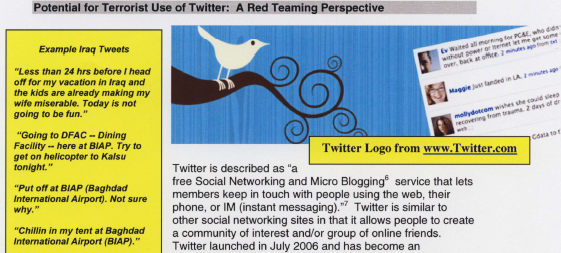U.S. Army warns of twittering terrorists
Intelligence community is concerned that terrorists might use microblogging tool Twitter to coordinate attacks, according to a purported draft report posted on Web.

The U.S. intelligence community is concerned that terrorists might use micro-blogging tool Twitter to coordinate attacks, according to a purported draft Army intelligence report posted on the Web.
The report--present by the 304th Military Intelligence Battalion and posted to the Federation of American Scientists Web site--examines the possible ways terrorists could use mobile and Web technologies such as the Global Positioning System, digital maps, and Twitter mashups to plan and execute terrorist attacks.
The report (PDF), which appears to have been first presented earlier this month, was reported Friday by Wired magazine's Noah Shachtman. A chapter titled "Potential for Terrorist Use of Twitter," presents general, introductory information on Twitter and how it works, and describes how the service was used to report details of a recent earthquake in Los Angeles and by activists at the Republican National Convention.
"Twitter has also become a social activism tool for socialists, human rights groups, communists, vegetarians, anarchists, religious communities, atheists, political enthusiasts, hacktivists and others to communicate with each other and to send messages to broader audiences," the report said.
The report goes on to say:
Twitter is already used by some members to post and/or support extremist ideologies and perspectives. Extremist and terrorist use of Twitter could evolve over time to reflect tactics that are already evolving in use by hacktivists and activists for surveillance. This could theoretically be combined with targeting.
The report describes hacktivists as politically motivated hackers.
The report also described scenarios in which terrorists could leverage "potential adversarial use of Twitter," such as planning ambushes or detonating explosives:
Scenario 1: Terrorist operative "A" uses Twitter with (or without) a cell phone camera/video function to send back messages, and to receive messages, from the rest of his cell. Operative "A" also has a Google Maps Twitter Mash Up of where he is under a code word for other members of his cell (if they need more in-depth directions) posted on the WWW that can be viewed from their mobiles. Other members of his cell receive near real time updates (similar to the movement updates that were sent by activists at the RNC) on how, where, and the number of troops that are moving in order to conduct an ambush.
Scenario 2: Terrorist operative "A" has a mobile phone for Tweet messaging and for taking images. Operative "A" also has a separate mobile phone that is actually an explosive device and/or a suicide vest for remote detonation. Terrorist operative "B" has the detonator and a mobile to view "A's" Tweets and images. This may allow "B" to select the precise moment of remote detonation based on near real time movement and imagery that is being sent by "A."
Scenario 3: Cyber Terrorist operative "A" finds U.S. [soldier] Smith's Twitter account. Operative "A" joins Smith's Tweets and begins to elicit information from Smith. This information is then used for a targeting package (targeting in this sense could be identity theft, hacking, and/or physical.) This scenario is not new and has already been discussed for other social networking sites, such as My Space and/or Face Book.
However, the overview notes that the research used to generate the report was gathered from open source intelligence and not compared with information in classified venues.

